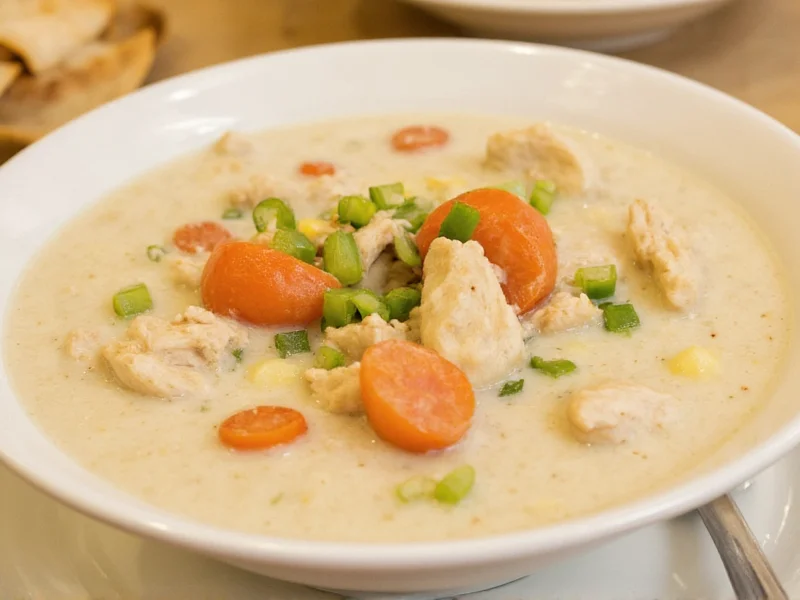When preparing chicken soup with cream, understanding the proper sequence prevents common kitchen disasters. Many home cooks make the mistake of boiling cream directly into hot broth, causing immediate separation. Professional chefs recommend tempering dairy by gradually mixing small amounts of warm broth into the cream before incorporating it into the main pot. This gradual temperature adjustment preserves the emulsion that creates that signature silky mouthfeel.
The Science Behind Perfect Cream Integration
Cream contains approximately 36-40% milk fat, which remains stable when properly incorporated into soups. The critical factor is managing protein denaturation - when dairy proteins exceed 180°F (82°C), they coagulate and separate from the liquid. Using heavy cream provides more stability than half-and-half due to its higher fat content. For dairy-free alternatives, full-fat coconut milk or cashew cream offer similar richness without the risk of curdling.
Classic Creamy Chicken Soup Recipe
This foundational recipe yields 6 servings with preparation time of 25 minutes and cooking time of 45 minutes. The technique focuses on building flavors in stages while protecting the dairy component.
Ingredients
- 1.5 lbs (680g) boneless, skinless chicken thighs
- 4 cups (950ml) quality chicken broth
- 1 cup (240ml) heavy cream
- 1 large yellow onion, finely diced
- 2 medium carrots, sliced 1/4-inch thick
- 2 celery stalks, sliced 1/4-inch thick
- 3 garlic cloves, minced
- 3 tbsp unsalted butter
- 3 tbsp all-purpose flour
- 1 tsp fresh thyme leaves
- Salt and white pepper to taste
Step-by-Step Instructions
- Simmer chicken thighs in broth for 25 minutes until cooked through (165°F/74°C internal temperature)
- Remove chicken, strain broth, and reserve both
- Sauté onions, carrots, and celery in butter until softened (8-10 minutes)
- Add garlic and flour, cooking 2 minutes to form roux
- Gradually whisk in reserved broth until smooth
- Return to simmer and cook 15 minutes until vegetables are tender
- Shred chicken and return to pot
- Reduce heat to 160°F (71°C), add cream and thyme
- Season with salt and white pepper (avoid black pepper for visual appeal)
- Simmer gently 5 minutes without boiling
Culinary Variations Worth Trying
| Variation Type | Key Modifications | Flavor Profile | Preparation Adjustment |
|---|---|---|---|
| French Velouté Style | Uses chicken velouté sauce base | Elegant, refined | Requires additional roux preparation |
| Mushroom Cream Fusion | Adds 8oz sautéed mushrooms | Earthy, umami-rich | Sauté mushrooms before vegetables |
| Dairy-Free Option | Substitutes coconut milk for cream | Slightly sweet, tropical notes | Add at very end (150°F/65°C) |
| Herb-Infused Version | Includes tarragon and chives | Grassy, aromatic | Add fresh herbs after cream |
Avoiding Common Preparation Mistakes
Temperature control remains the most critical factor in successful creamy chicken soup. Adding cold cream directly to boiling broth guarantees curdling. Instead, maintain soup temperature below 180°F (82°C) before incorporating dairy. Another frequent error involves over-seasoning early in the process - salt concentration intensifies as liquid reduces, so season incrementally throughout cooking.
For optimal texture, avoid boiling after cream addition. The ideal serving temperature is 165-175°F (74-80°C), hot enough to enjoy but below the curdling threshold. If separation occurs, an immersion blender can temporarily restore emulsion, though prevention remains superior to correction.
Storage and Reheating Best Practices
Properly stored creamy chicken soup maintains quality for 3-4 days in airtight containers. When reheating, use low temperatures (medium-low on stove or 30% power in microwave) with frequent stirring. Adding a splash of broth or milk during reheating helps restore original consistency. Freezing creamy soups presents challenges as dairy components may separate upon thawing - for best results, freeze base soup without cream and add dairy when reheating.
Seasonal Adaptations for Year-Round Enjoyment
Summer versions benefit from lighter cream proportions (1/2 cup instead of 1 cup) with added fresh herbs like dill or chervil. Winter preparations can incorporate roasted root vegetables for natural sweetness that balances the richness. During spring, pea shoots or asparagus tips added at the end provide vibrant color contrast against the pale broth. Fall iterations shine with wild mushrooms and toasted hazelnuts for textural contrast.
Can I use milk instead of cream in chicken soup?
Yes, but with important considerations. Whole milk works better than low-fat varieties due to higher fat content. Add milk at temperatures below 160°F (71°C) and avoid boiling. For better results, create a slurry with 2 tablespoons cornstarch mixed with cold milk before adding to the soup to prevent curdling.
How do I fix curdled cream in soup?
Immediately remove from heat and let cool slightly. Use an immersion blender to re-emulsify the mixture. Alternatively, whisk in 1-2 tablespoons of cold broth to help restore the emulsion. For severe separation, strain the soup and create a new cream base to incorporate.
What's the difference between cream of chicken soup and creamy chicken soup?
Cream of chicken soup typically refers to a condensed canned product requiring dilution, while creamy chicken soup describes a from-scratch preparation featuring actual chicken pieces in a cream-enriched broth. Authentic creamy chicken soup contains visible chicken and vegetables, whereas cream of chicken often has a uniform texture.
Which thickening method works best for creamy chicken soup?
Roux-based thickening (butter and flour cooked together) provides the most stable base for dairy incorporation. Vegetable purees like cauliflower or potatoes offer natural thickening without altering flavor significantly. Avoid cornstarch in dairy-heavy soups as it can create an unpleasant texture when combined with proteins in cream.











 浙公网安备
33010002000092号
浙公网安备
33010002000092号 浙B2-20120091-4
浙B2-20120091-4